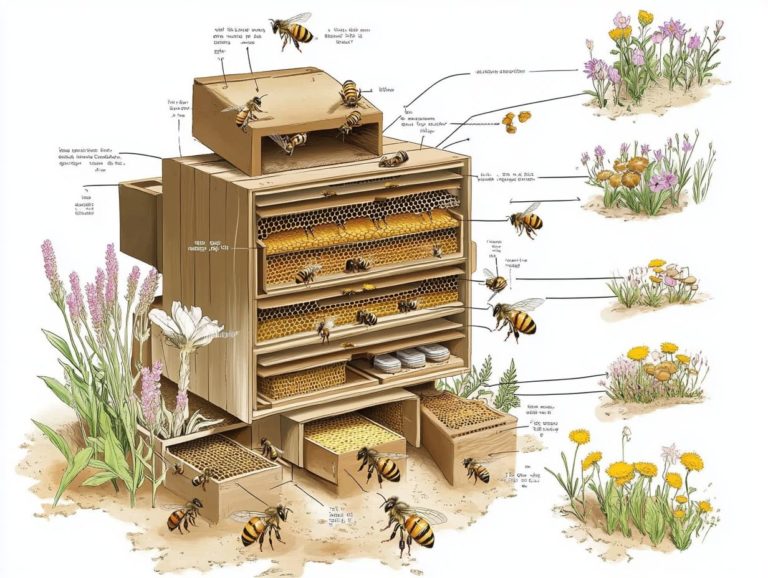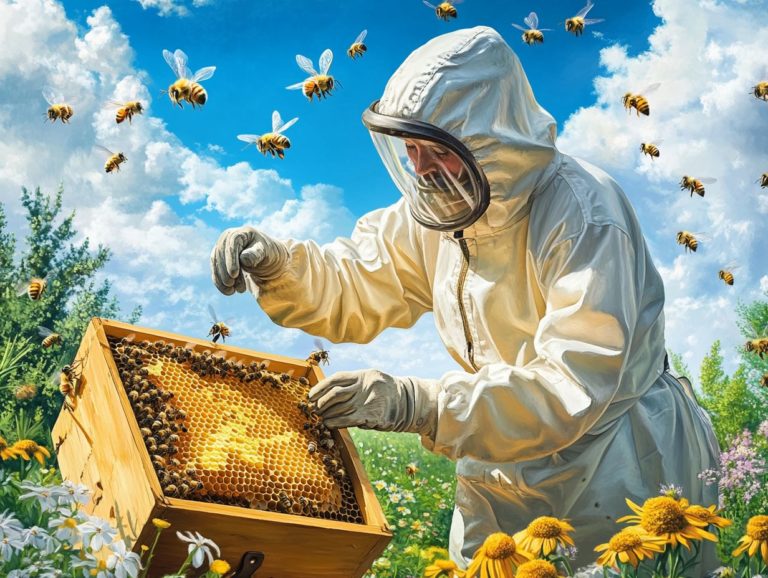Understanding Honeybee Behavior in Hives
Honeybees, specifically the species Apis mellifera, are remarkable beings that hold significant importance within our ecosystem. They exhibit complex social structures and behaviors in hives that are essential to their survival.
In this exploration, you will discover the inner workings of honeybee communities, including the pivotal role of the queen bee, the hive conditions, and the various responsibilities of worker bees, such as foraging and defending the hive. You will uncover the fascinating factors that influence their behavior and communication methods, including the extraordinary waggle dance, which conveys vital information about nectar resources and pollen collection.
Understanding these dynamics is vital for beekeepers, scientists, and conservationists, as it highlights the critical role honeybees play in our world.
Contents
Key Takeaways:
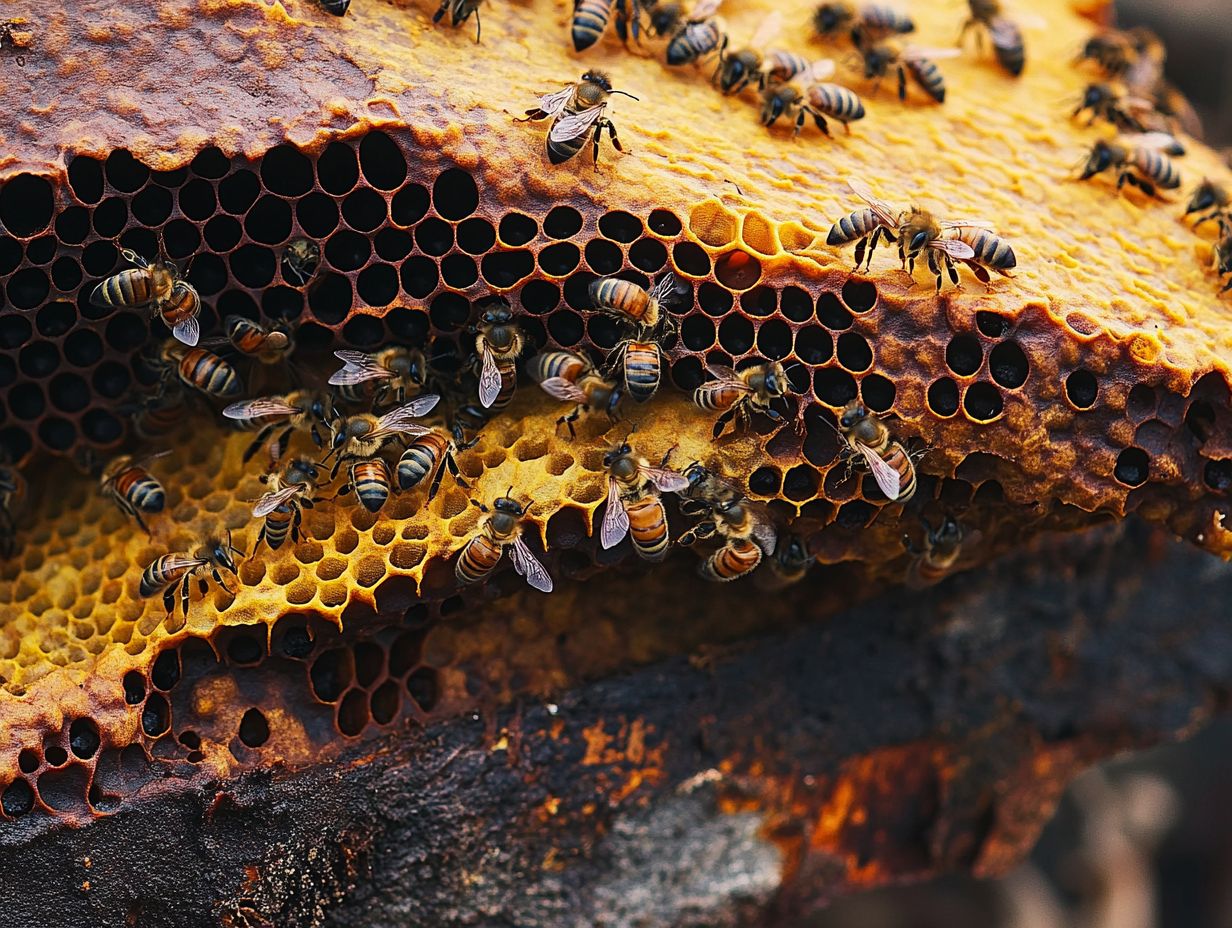
- Honeybees have a complex social structure in hives, with different roles for the queen bee, worker bees, and male drones.
- Genetics, environment, and pheromones are all factors that shape honeybee behavior in hives, affecting aspects like hive defense and egg laying.
- Understanding honeybee behavior is crucial for beekeepers, scientists, and conservation efforts to effectively manage and protect these important pollinators.
What Are Honeybees?
Honeybees, especially the species Apis mellifera, are fascinating social creatures that create intricate colonies, playing a crucial role in ecosystems and agricultural practices. Their unique behaviors and honey production are truly captivating.
As vital pollinators, honeybees nurture the growth of a wide variety of plants and crops. In their complex social structure, you will find a queen bee, diligent worker bees, and male drones, all working together to ensure the colony thrives and operates efficiently.
Their contributions are absolutely essential, and understanding their role enriches your appreciation for these extraordinary insects.
What Is A Hive?
A hive is a carefully built home crafted by honeybees, serving as the very heart of a bee colony. Within the hive, they engage in activities such as brood nursing and hive defense. They also store honey, nurture developing larvae, and maintain conditions essential for their survival.
Did you know that hives can be built in many different ways? Options include Langstroth, Top-Bar, and Warre hives, each designed to promote optimal communication and efficiency among the bees. These hives feature wax combs, which are vital for brood rearing and honey storage, providing the bees with a necessary framework to build their food reserves and raise the next generation.
Each type of hive plays a pivotal role in colony dynamics, influencing foraging habits, defensive behavior, and overall productivity. By learning about these structures, you can enhance hive activity and better support the health and vitality of your colonies.
How Do Honeybees Behave In A Hive?
Honeybee behavior within a hive is a marvel of organization, with distinct roles assigned to the queen bee, worker bees, and male drones. This includes tasks like brood feeding, temperature regulation, and hive inspection. Such precision ensures the hive not only thrives but also survives through a range of essential activities.
From brood nursing to hive defense and temperature regulation, each role plays a critical part in maintaining the optimal conditions necessary for the hive’s well-being.
1. The Role Of The Queen Bee
The queen bee is the pivotal figure in a honeybee colony. She takes on the crucial responsibility of laying eggs and strengthening the colony through her chemical signals, which help bees communicate.
These signals regulate the behavior of the worker bees, contributing significantly to the overall harmony of the hive. They serve a critical function, signaling not only when the colony is thriving but also indicating moments of distress or the need for swarming.
By emitting specific compounds, the queen influences how the worker bees care for the queen cells, nurturing potential successors and ensuring adaptations essential for the colony’s survival. Her health directly affects the reproduction rate and dynamics within the colony.
A robust queen will produce more eggs, fostering a well-populated hive. This amazing connection shows just how vital the queen bee is to the hive’s success!
2. The Tasks Of Worker Bees
Worker bees carry out a remarkable array of tasks vital for the hive’s survival. They include foraging and hive defense.
From collecting nectar and pollen to nurturing developing larvae and defending the hive from threats, these industrious insects embody a model of teamwork and dedication.
As the backbone of the colony, worker bees transition through various life stages, each marked by distinct responsibilities. In their early days, they focus on maintaining the hive, cleaning cells, and ensuring a conducive environment for the queen and her brood.
As they mature, they step into the critical role of foragers, bravely venturing out to gather nectar and pollen, which ultimately contribute to honey production.
Their remarkable ability to communicate through dances enhances the efficiency of foraging, playing a significant role in the hive s prosperity. This scent communication is essential for worker cohesion and hive activity.
This division of labor doesn t just ensure the hive s vitality; it also reinforces the entire ecosystem, brilliantly illustrating the essential interdependence of each bee s tasks.
3. The Life Cycle Of Honeybees
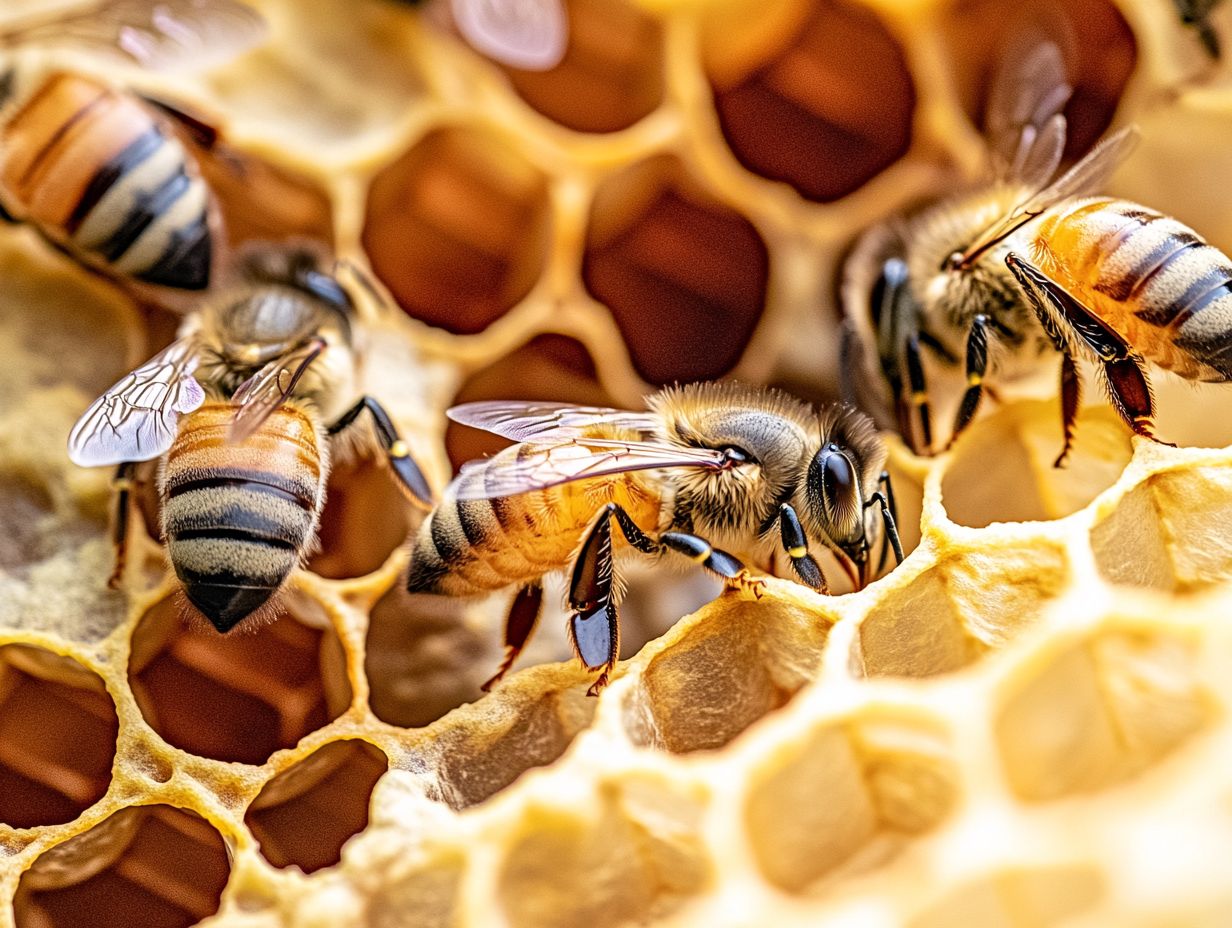
The life cycle of honey bees unfolds through several distinct stages, beginning with egg laying and culminating in maturation. This process includes important phases like brood development and care of developing larvae.
As a pivotal part of this process, developing larvae undergo brood development, essential for sustaining a healthy bee population and ensuring the colony’s survival through winter.
This fascinating cycle starts when the queen lays her eggs in hexagonal wax cells within the hive. Here, diligent worker bees meticulously regulate temperature and humidity.
Once the eggs hatch into larvae, they are nurtured with a rich diet of royal jelly, pollen, and honey nutrients vital for their growth. The interaction between the bees and their environment plays a crucial role, as seasonal variations determine the availability of nectar and pollen.
This directly affects the health of the brood. During spring and summer, the hive buzzes with activity, creating optimal conditions for brood rearing and nectar flow.
In contrast, autumn brings a shift in focus, requiring strategic adjustments in brood production to ensure adequate food stores and a balanced population as the colony faces the challenges of winter.
What Are The Factors That Affect Honeybee Behavior In Hives?
Numerous factors play a crucial role in shaping honeybee behavior within their hives. Environmental conditions, the state of the hive, and agricultural practices can all profoundly impact the health and population of these essential pollinators.
Understanding these influences is key to fostering a thriving bee community.
Join the movement to protect these vital pollinators!
1. Genetics
Genetics plays a pivotal role in shaping honey bee health, colony strength, and overall behavior, influencing key traits such as foraging efficiency, disease resistance, and the effectiveness of the swarming process.
Recent studies reveal that genetic diversity within bee populations significantly enhances their adaptability, resulting in improved survival rates when faced with environmental stresses and pathogens. For instance, specific traits like Varroa mite resistance have been linked to certain genetic markers, suggesting that selective breeding could effectively strengthen colonies.
Your understanding of honey bee foraging patterns will deepen as you discover how their genetic makeup can profoundly affect their abilities, with some lines displaying remarkable proficiency in locating food sources. This is vital for sustaining large colonies and their honey reserves.
This genetic variation not only promotes resilience in individual bees but also boosts the vitality and productivity of the entire colony, highlighting the intricate relationship between genetics and behavior in the captivating world of honey bees.
2. Environment
Environmental conditions, such as the availability of nectar flow and diverse pollen sources, play a crucial role in influencing hive activity and the foraging behaviors of honey bees, ultimately impacting their food reserves, honey production, and overall well-being.
This intricate relationship underscores how fluctuations in weather patterns, including temperature extremes and rainfall, can greatly change local plant life. When flowering plants bloom late due to unseasonable weather, honey bees may struggle to locate adequate food sources, directly affecting their foraging efficiency.
Climate change shifts habitats and affects when plants grow, making it harder for bees to find essential nutrients and influencing their nesting sites.
As flower availability decreases or becomes unpredictable, hive dynamics can shift, potentially leading to reduced colony strength and heightened vulnerability to diseases.
Knowing these factors is crucial for your conservation efforts to keep bee populations thriving!
3. Pheromones
Pheromones are crucial in regulating honey bee behavior within the hive, influencing activities such as brood nursing and hive defense. These chemical signals play a significant role in ensuring worker cohesion and effective scent communication, which are essential for maintaining hive activity and overall colony health.
Pheromones shape worker cohesion, hive defense strategies, bee behavior, and the overall organization of the colony, ensuring everything runs smoothly and efficiently.
These chemical signals coordinate various activities within the colony, from foraging, brood care, and swarming bees, to, most critically, defensive responses. For instance, when guard bees release alarm pheromones, they spark an immediate defensive reaction, urging workers to shield the hive from intruders such as predators or rival bees. On the flip side, reproductive pheromones emitted by the queen reinforce her dominance and entice male drones for mating, a crucial element in preserving the genetic vitality of the colony.
Other pheromones indicate the presence of food, facilitating effective foraging strategies, pollen collection, and optimal resource management within the hive. Therefore, these chemical signals are far more than mere odors; they represent intricate messages that govern the complex social structure and survival of honey bee colonies.
How Do Honeybees Communicate In A Hive?
Honeybees employ remarkably sophisticated communication methods within their hives, most notably through the waggle dance, pheromones, and bee flight. These intricate signals convey essential information regarding food sources, hive activity, developing larvae, and the overall needs of the colony, showcasing the remarkable intelligence and organization of these industrious insects.
1. The Waggle Dance Explained

The waggle dance represents a captivating method of communication among honeybees, conveying essential information about the location of nectar resources. This intricate dance guides fellow bees in their search for food and invigorates the activity within the hive.
Through a series of precise waggles and turns, the waggle dance not only provides clear directional cues but also imparts vital details regarding the distance and quality of the food source. When a worker bee stumbles upon a bountiful patch of flowers, she performs this elaborate dance on the honeycomb, translating her findings for the rest of the colony. In doing so, she synchronizes the hive’s foraging efforts with its immediate nutritional needs, ensuring optimal resource acquisition.
This collaborative strategy enhances foraging efficiency, directly reflecting the collective demands of the hive and colony survival. It highlights the sophisticated social structure that empowers honeybees to flourish in a variety of environments, especially during the spring season.
2. How Pheromones Work
The pheromone trail is a fundamental aspect of honeybee communication, with distinct scents that signify various activities and conditions within the hive. These signals shape foraging patterns and influence overall bee behavior.
These chemical signals, released by worker bees, enable the colony to function cohesively and efficiently, helping ensure that tasks like caring for baby bees and collecting pollen are done well. For instance, when you, as a forager, discover a bountiful nectar source, you emit a specific pheromone that encourages others to join you in capitalizing on this valuable resource.
This communication system also amplifies foraging efficiency and equips the hive to respond swiftly to potential threats. Alarm pheromones, for example, act as a rapid alert system against predators, prompting the colony to engage in defensive actions.
Understanding the role of these pheromones helps you gain insight into the intricate social structure, survival strategies, and honey bee behavior that bees employ within their complex ecosystems.
Why Is Understanding Honeybee Behavior Important?
Grasping honeybee behavior is essential for you as a beekeeper, scientist, or conservationist, as it offers valuable insights into how the hive operates, the health of honey bees, honey bee species, and the various factors that impact their survival and productivity.
1. For Beekeepers
For you as a beekeeper, understanding honeybee behavior is absolutely essential for conducting effective hive inspections, maintaining colony strength, understanding hive conditions, and maximizing honey production. This knowledge empowers you to respond adeptly to the needs and conditions of your bees.
By keenly observing the intricate dynamics within the hive, you can spot early signs of stress, disease, or potential queen issues elements that are crucial for timely interventions. When you learn to recognize specific behaviors, such as a decline in foraging activity or unusual clustering patterns, it becomes significantly easier to troubleshoot problems before they spiral out of control, such as issues related to queen cells or swarm cells.
With the right insights into how bees react to environmental changes, agricultural practices, and hive conditions, you can refine your strategies for honey production, ensuring that your efforts yield the most rewarding results. This understanding nurtures healthier colonies and elevates your overall beekeeping experience to new heights!
Dive deeper into the fascinating world of honeybees and enhance your beekeeping skills today!
2. For Scientists
As you delve into the study of honeybee behavior, you unlock valuable insights into environmental factors that influence colony survival. These factors include temperature regulation and robbing behavior.
By observing how these industrious pollinators interact with their environment, you gain a clearer understanding of the intricate web of ecological relationships that sustain numerous plant species. Ultimately, this contributes to our food supply.
Honeybees are crucial indicators of environmental health. Their decline underscores pressing challenges within ecology and conservation efforts.
Their behaviors ranging from foraging patterns to how bees interact in their hives reveal critical information about the impacts of climate change, pesticide use, and habitat loss.
By addressing these issues through the lens of honeybee studies, you not only enrich your understanding of biodiversity but also lay the groundwork for informed strategies to ensure the survival of these essential pollinators.
Prioritizing honeybee behavior is vital for enhancing their winter survival!
3. For Conservation Efforts
Your conservation efforts focused on honeybees will depend significantly on your understanding of their behavior and hive defense. This knowledge serves as a guiding light for initiatives aimed at enhancing bee health and ensuring the resilience of colonies in the face of shifting environmental conditions.
By recognizing the intricate social structures, foraging habits, brood development, and communication methods of these remarkable pollinators, you can improve strategies for habitat restoration and population recovery.
Behavioral studies reveal how honeybees react to various stressors, such as pesticide exposure, environmental conditions, and habitat loss. This offers essential insights for developing effective conservation practices.
With a clear grasp of these dynamics, you can tailor your approaches to supply the vital resources and conditions honeybees require to flourish. This includes providing suitable nesting sites and food reserves.
Ultimately, prioritizing honeybee behavior supports a broader ecological balance. These essential creatures play a crucial role in pollination, honey stores, and food security.
Frequently Asked Questions
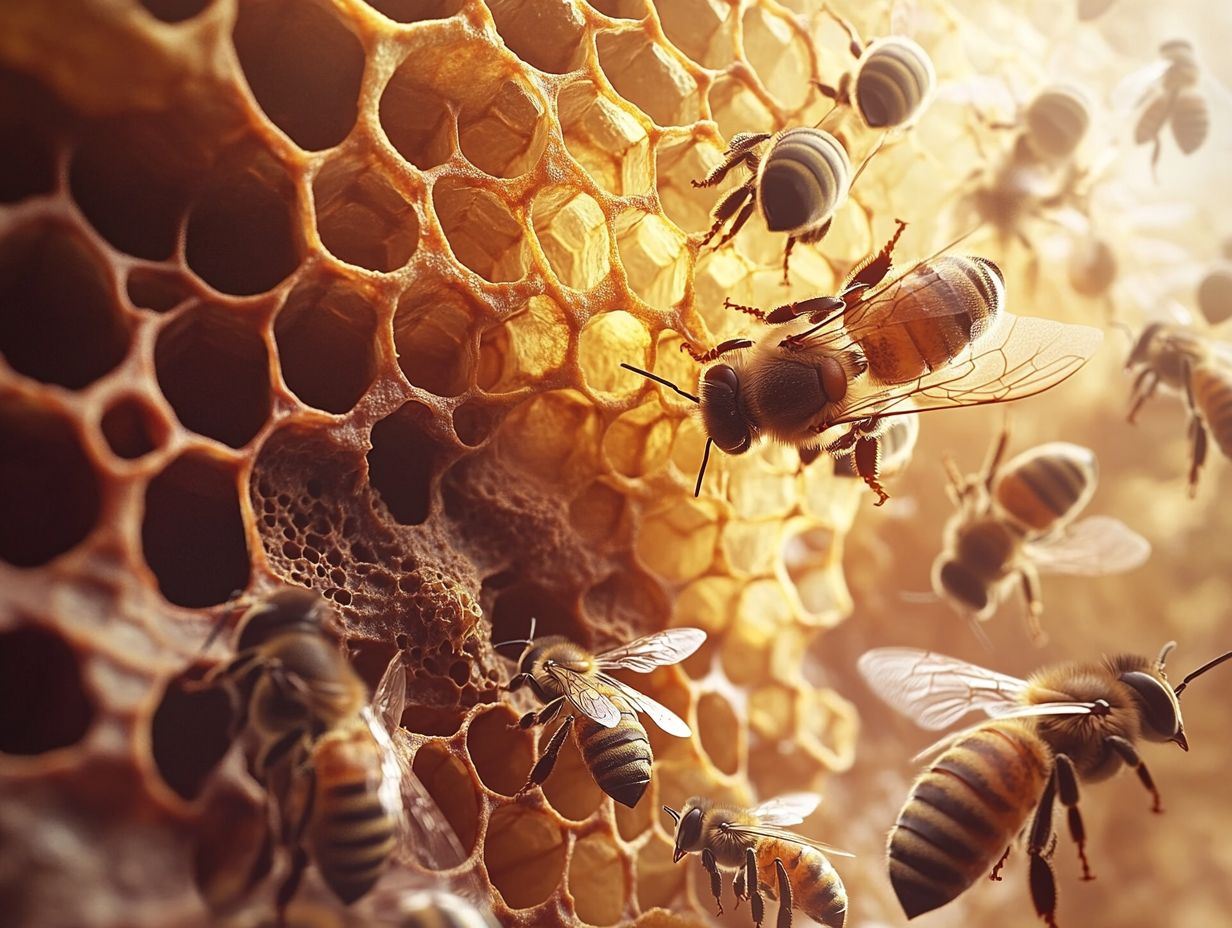
What is the role of the queen bee in a hive?
The queen bee, known as Apis mellifera, is vital to the colony. She is responsible for reproduction and the hive’s stability.
She lays all the eggs, ensuring a steady supply of worker bees, drones, and future queens. This process is essential for the bee population’s growth and sustainability!
How do honeybees communicate with each other?
Honeybees, which include various honey bee species, use various communication methods, including pheromones, vibrations, and dance movements. Pheromones are chemical signals released by bees to relay information about food sources, danger, and the location of the hive.
Vibrations are used to signal the direction and distance of a food source, such as nectar and pollen. Dance movements indicate the direction and quality of a food source.
Why do honeybees swarm?
Honeybees swarm when the current hive becomes overcrowded, and there is not enough space for the colony to expand. The old queen will leave with a large portion of the worker bees to find a new home.
This initiates the swarming process, while a new queen will take over the original hive and continue laying eggs.
How do honeybees make honey?
Honeybees collect nectar from flowers and store it in their honey stomachs. Once they return to the hive, they transfer the nectar to other worker bees who will then continue to process it.
The nectar is broken down into simple sugars and stored in honeycomb cells, where it is fanned by the bees’ wings to remove excess moisture and create the thick, sweet substance we know as honey.
What is the purpose of the worker bees in a hive?
Worker bees are responsible for collecting nectar, pollen, and water, maintaining the hive, caring for the queen and her eggs, brood feeding, and protecting the colony from predators. They also produce beeswax, which is used to build honeycomb cells, such as wax combs, and ripen and cap honey for storage.
How can understanding honeybee behavior in hives benefit beekeepers?
By understanding honeybee behavior, beekeepers can better manage their hives and ensure the health and productivity of their colonies. They can also identify potential issues, such as disease or pest infestations, queen issues, and take appropriate measures to address them. Additionally, understanding honeybee behavior can help beekeepers maximize honey production, maintain a sustainable apiary, and ensure overall honey bee health.




